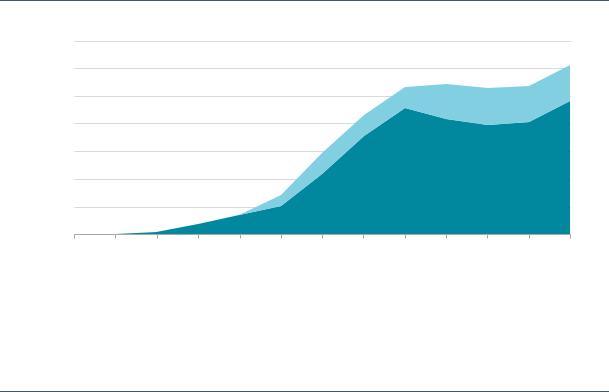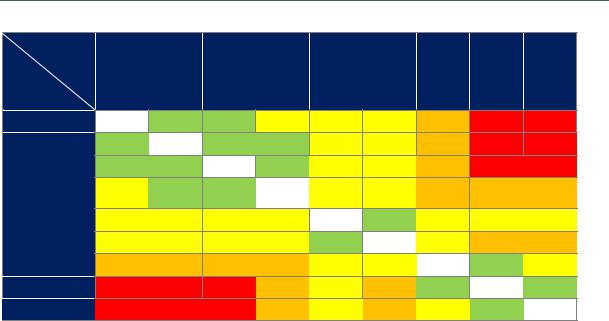
- •Abstract
- •Foreword
- •Executive summary
- •The drive for flexibility
- •Driven by portfolio players, LNG contracting activity rebounded to its highest level in five years…
- •… underpinned by longer, larger and more flexible contracts
- •Innovation in LNG contracting to enhance regional security of supply…
- •…means traditional buyers could become a larger source of additional flexibility for the Asian LNG market
- •The transformation of the broader energy system in north-western Europe…
- •…calls for the further enhancement of downstream gas flexibility
- •Findings and recommendations
- •Key findings
- •Update on LNG market flexibility metrics
- •LNG supply security in Asia: An opportunity for traditional buyers
- •North-western Europe’s gas flex: Still fit for purpose?
- •Technical analysis
- •1. Update on LNG market flexibility metrics
- •Introduction
- •Update on LNG contract trends
- •Liquefaction activity: New wave of investment gaining momentum
- •Export source and import destination: Flexible gas gaining ground
- •Longer and larger contracts do not mean less flexibility
- •Portfolio players and flexibility
- •Analysis of contract flexibility
- •Pricing trends
- •References
- •2. LNG supply security in Asia: An opportunity for traditional buyers?
- •Introduction
- •LNG flexibility in Asia
- •Flexibility in long-term contracts
- •Options in LNG contracts
- •Valuation of options
- •Flexibility in Japanese LNG contracting
- •Innovation in contracting
- •Expansion of LNG network
- •Creating joint ventures
- •Expanding LNG outlets
- •Proximity and security of supply
- •References
- •3. North-western Europe’s gas flex: Still fit for purpose?
- •Introduction
- •Gas flexibility toolkit
- •North-western Europe’s gas demand: Seasonality and volatility
- •Current state of flexibility tools
- •Upstream deliverability
- •Import capacity
- •Midstream interconnectivity
- •Storage capacity
- •A transforming energy system
- •References
- •General annex
- •Abbreviations and acronyms
- •Acknowledgements
- •Table of contents
- •List of figures
- •List of boxes
- •List of tables

Global Gas Security Review 2019 |
2. LNG supply security in Asia: An opportunity for traditional buyers? |
Expanding LNG outlets
JERA has been active in creating new LNG demand in the Asia Pacific region, which would eventually be helpful for managing the supply and demand balance within JERA’s portfolio. In 2019 JERA started FSRU and gas distribution businesses in Eastern Australia with the Japanese trading company Marubeni. JERA is also in the process of launching an LNG bunkering business and currently has an LNG bunkering vessel under construction, due for delivery in 2020. JERA plans to source the LNG from its stockpile, to be reloaded at JERA’s Kawagoe LNG receiving terminal (reloading facility currently under construction). Then the LNG bunker vessels will provide LNG fuel for Toyota’s vehicle carrier vessels en route between Japan and the west coast of the United States.
Proximity and security of supply
IEA analysis shows that emerging Asian LNG buyers have the potential to experience uncontracted demand in the medium term, while also requiring volume optimisation due to limited receiving terminal capacity until new infrastructure is constructed or connected. One solution to this could be the flexible supply provided by the traditional Asian LNG buyers. These buyers have experience of market dynamics with 50 years of safe operational capability, using flexibilities in their long and short-term contracts to meet uncertain demand. Given their requirement to create new demand to absorb potential excess contracted volumes, they are well-positioned to provide a solution – currently 15 bcm/y of volumes contracted to traditional Asian LNG buyers are considered to be destination-flexible. This destination-flexible volume is expected to double to 31 bcm/y by 2024, which would cover up to 15% of forecast LNG demand for emerging Asian LNG buyers, if all are to be provided (Figure 35).
Figure 35. LNG volumes contracted to traditional Asian LNG buyers with flexible destination (2012–24)
bcm/y
35
30
25
20
15
10
5
0 |
|
|
|
|
|
|
|
|
|
|
|
|
|
|
2012 |
2013 |
2014 |
2015 |
2016 |
2017 |
2018 |
2019 |
2020 |
2021 |
2022 |
2023 |
2024 |
||
|
|
|
|
|
|
Japan |
|
|
Others |
|
|
|
|
|
|
|
|
|
|
|
|
|
|
|
|
|
|
||
Source: IEA analysis based on data from ICIS (2019), ICIS LNG Edge, www.icis.com/explore/services/analytics/lng-market-intelligence- solution/ (subscription required); 2024 is based on LNG forecast import data from IEA (2019), Market Report Series: Gas 2019, https://webstore.iea.org/market-report-series-gas-2019.
Flexible LNG from traditional Asian LNG buyers is set to cover up to 15% of LNG demand from emerging Asian LNG buyers, providing extra flexibility in the region.
This destination-flexible LNG volume would be seen to be suitable for diverting to emerging Asian buyers, where over 40% of demand growth is expected to originate in the coming years. The development of a market expected to see such robust demand growth would have a great impact on regional and global security of supply. Table 1 shows that Northeast Asian LNG buyers (Japan,
PAGE | 44
IEA. All rights reserved.

Global Gas Security Review 2019 |
2. LNG supply security in Asia: An opportunity for traditional buyers? |
Korea, China) – and emerging LNG buyers – Southeast Asia (Singapore, Thailand) and South Asia (India, Bangladesh, Pakistan) – are all relatively close to one another (within four sea voyage days).
Table 1. Laden voyage days between major Asian LNG delivery ports
From |
Japan |
Korea |
China (north) |
China (south) |
Singapore |
Thailand |
India (east) |
India (west) |
Pakistan |
|
To |
||||||||||
|
|
|
|
|
|
|
|
|
||
Japan |
|
2.6 |
3.4 |
4.4 |
7.6 |
7.7 |
11.7 |
14.6 |
15.1 |
|
Korea |
2.6 |
|
1.8 |
3.2 |
6.5 |
6.6 |
10.6 |
12.9 |
14.0 |
|
China (north) |
3.4 |
1.8 |
|
3.9 |
7.3 |
7.2 |
11.3 |
13.5 |
14.7 |
|
China |
4.4 |
3.2 |
3.9 |
|
4.1 |
4.2 |
8.1 |
10.4 |
11.5 |
|
(south) |
|
|||||||||
|
|
|
|
|
|
|
|
|
||
Singapore |
7.6 |
6.5 |
7.3 |
4.1 |
|
2.1 |
4.1 |
6.3 |
7.5 |
|
Thailand |
7.7 |
6.6 |
7.2 |
4.2 |
2.1 |
|
6.2 |
8.4 |
9.6 |
|
India (east) |
11.7 |
10.6 |
11.3 |
8.1 |
4.1 |
6.2 |
|
3.8 |
5.0 |
|
India (west) |
14.6 |
12.9 |
13.5 |
10.4 |
6.3 |
8.4 |
3.8 |
|
1.3 |
|
Pakistan |
15.1 |
14.0 |
14.7 |
11.5 |
7.5 |
9.6 |
5.0 |
1.3 |
|
|
Less than 4 |
|
4 to 8 days |
|
8 to 12 days |
|
Over 12 days |
|
days |
|
|
|
|||
|
|
|
|
|
|
IEA, 2019. All rights reserved. |
|
|
|
|
|
|
|
|
Notes: Durations only account for days at sea and do not include loading and offloading days. For the purpose of analysis, “Japan” refers to Tokyo Bay area, “Korea” to Pusan, “China north” to Tianjin, “China south” to Guangzhou, “Singapore” to Jurong, “Thailand” to Sriracha, “India (east)” to Chennai, “India (west)” to Mumbai, and “Pakistan” to Karachi.
Source: IEA calculation assuming an average speed of 16 knots, taking into account that the vessels would limit their maximum speed due to the close proximity to other buyer countries, based on distances from sea-distances.org.
Analysis shows that the nearest terminals can be reached within three voyage days, enabling fluctuations in supply and demand to be met promptly. The requirements of traditional buyers (highly dependent on LNG supply, yet with fluctuating demand) and of emerging buyers (LNG demand set to increase, but infrastructure immature and price sensitivity currently hindering the signing of long-term contracts) could be mutually beneficial for stronger regional security of supply. Traditional buyers, who already maximise their own use of the secondary market, can play a new role by becoming sellers of LNG in a secondary market that is at the stage of developing in the wider Asia region.
Contract flexibility and means of implementation – examples such as reloading, partnerships and ISO container loading – would bring interconnectivity between the parties to the region, with ehnhanced readiness to manage supply and demand disruption. Similar to the operational experiences of global portfolio players, traditional Asian LNG buyers can become sellers providing robustness to the operation of immature emerging market infrastructure.
Furthermore, as seen in traditional buyers expanding their LNG network beyond the region – accessing out-of-region terminals and using sourced LNG as bunker fuel – the LNG network and the security it brings are set to expand interregionally. Diversion or time-swapping optimisation are currently observed between bilateral buyers within the region, while reloading trade flows are mainly observed from Europe to Asia, where excess supply has been delivered to meet demand. Traditional Asian LNG buyers are well placed to further increase regional trading flows by selling LNG into markets where new demand is set to rise.
PAGE | 45
IEA. All rights reserved.
